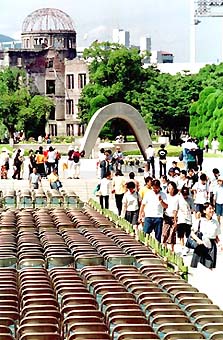55th anniversary of Hiroshima A-bombing tomorrow
8/5/00 
Hiroshima will observe its 55th "A-bomb
day" tomorrow, August 6th. The 20th
century has been aptly called the "nuclear
century," and in the end, we will enter
the next century without a clear path to
nuclear weapons abolition. One by one, the
survivors succumb to the illness or old age
and vanish from our midst. How can those
of us who follow share their determination
to create an international consciousness
that can lead the way to a "nuclear-free
21st century" The role of the A-bombed
cities grows in gravity. (Keita Tochiyabu)
At the end of March, 297,613 survivors still
lived in Japan. After peaking in March 1981,
their numbers continue to decline. Now they
have slipped below 300,000. Hiroshima's survivor
population is 90,184 (34,986 men and 55,198
women). Their average age is 69.4 years,
a 0.7 rise since last year.
During this, the final year of the century,
much nuclear-related news has dismayed the
people of Hiroshima. At the end of September
1999, Japan's first critical nuclear accident
in Tokai Village, Ibaragi Prefecture, created
a calamity that killed two persons and exposed
439 others to abnormal levels of radiation.
This drove home the reality that even Japan,
which has suffered atomic bombings, is forgetting
the nuclear lessons it learned.
Outside Japan, though the Cold War structure
collapsed long ago, the US Senate refused
to ratify the the Comprehensive Test Ban
Treaty (CTBT). The US has conducted four
sub-critical nuclear tests this year. The
influence of governments that rely on nuclear
deterrence only grows. The fear that India
and Pakistan may conduct more nuclear tests
is ever present.
Not a single head of state at the Okinawa
Summit even appeared to consider touring
the A-bomb exhibition held by Hiroshima and
Nagasaki. As it enters the next century,
Hiroshima's weighty task is to find a way
to bring the human tragedy of the atomic
bombing to the consciousness of world policy-makers.
Although no deadline was set, the Nuclear
Non-Proliferation Treaty (NPT) Review Conference
in May succeeded for the first time in securing
from the nuclear weapon states an "unequivocal
promise" in the final document to abolish
their nuclear arsenals. The A-bombed city
of Hiroshima must now grapple with the question
of how to press for fulfillment of that promise.
In his Peace Declaration, Hiroshima Mayor
Tadatoshi Akiba will state that Hiroshima
intends to demonstrate the ability to "reconcile"
human beings with the scientific technologies
that created nuclear weapons and are destroying
our environment. Transcending the benefit
or blame related to the perpetrator versus
victim issue in the atomic bombing, and sublimating
its grief and rage in its drive to eliminate
nuclear weapons, an idea that embraces all
humanity, Hiroshima is an appropriate candidate
for "model city," but the people
will be challenged by the process of concretely
defining and embodying that role.
.
[Caption] In Peace Memorial Park preparations are
virtually complete for the century's final
Peace Memorial Ceremony. (August 4, Hiroshima
City)
| next | back |